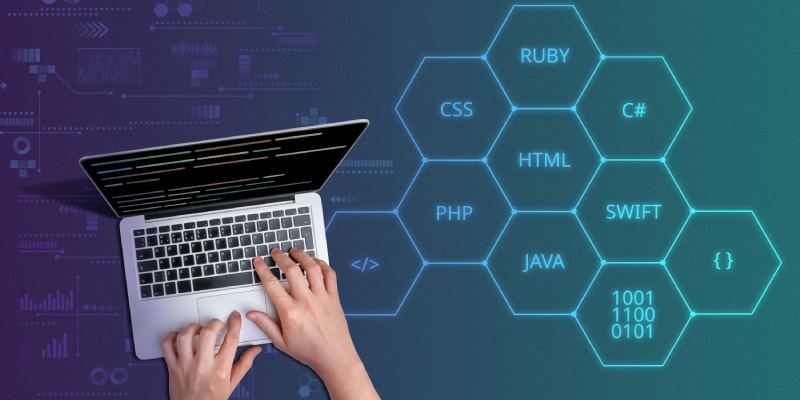Table of Content
ToggleUnderstanding Web Development
It is a versatile and multifaceted discipline aimed at crafting and maintaining websites. It necessitates a comprehensive understanding of the tools and frameworks required to construct web pages that are not only responsive but also interactive and visually appealing.
This field encompasses two core categories: front-end web development and back-end web development.
Before we delve into the selection of the most suitable languages for web development in 2023, let’s address some fundamental questions that may be on your mind.
Is Web Development Worth It in 2023-2024?
The world of web development is constantly evolving, with an expected 28.7 million developers by 2024. To thrive in this competitive field, continuous learning and skill upgrades are imperative. The role of a web developer offers lucrative career opportunities and is in high demand due to the increasing digitization of businesses worldwide. Websites have become the primary means for companies to engage with their clients, offering solutions for UX, cybersecurity, blockchain, IoT, AI, ML, and more.
Which Latest Web Development Languages are in Demand?

In the realm of web development, JavaScript (JS) reigns supreme with a staggering 63.61% demand, making it the most sought-after language. Following closely is the HTML/CSS combination at 52.97%, while Python claims the third spot, solidifying its presence in the industry.
Which are Growing in Popularity?
Python’s popularity is on the rise thanks to its readable syntax, strong community support, and reusable codes. It’s widely used in automation testing, making it a favourite among testers and developers. JS, HTML, and CSS maintain consistent demand as the foundational languages of web development. Another contender, TypeScript, is gaining traction due to its scalability and readability.
Latest Web Programming Languages
In the fast-paced world of technology, staying ahead in web development requires keeping up with the latest programming languages and trends.
Let’s explore the latest leading web Programming languages that are shaping the digital landscape in 2023.
Top 7 Latest Web Programming Languages for Back-end

Let’s analyze the Latest Top 7 Back-end Web Programming Languages in 2023.
Python
Key Features:
- Supports Object-Oriented Programming (OOP), functional programming, and structured programming.
- Offers various web development frameworks.
- Easily integrates with other programming languages.
- Provides dynamic typing capabilities for consistent content changes in complex websites.
PHP
PHP, an open-source scripting language, is ideal for dynamic and complex websites. It runs on the server side and creates dynamic pages. One of its standout features is its ability to integrate seamlessly with HTML, supporting various databases and offering in-built error reporting constants.
Key Features:
- Seamless integration with HTML.
- Support for major databases like MySQL and ODBC.
- Provides in-built error reporting constants for reporting errors.
- Offers platform independence and local server support.
Java
Java is an object-oriented, platform-independent language that prioritizes security. With a syntax rooted in C++, it offers a range of testing frameworks for unit testing in Java, such as Selenium and JUnit.
Key Features:
- Object-Oriented Programming (OOP) concepts include class, object, inheritance, encapsulation, polymorphism, and abstraction.
- Strong security features, disallowing pointers like C and C++.
- Supports multiple threads and effective memory management.
PHP
C# is another object-oriented language developed by Microsoft for the .NET framework. Widely recognized for game and mobile application development, it boasts type-safety coding and features like scalability and robustness.
Key Features:
- Type-safety coding, preventing unsafe typecasting.
- Offers scalability, updates, robustness, and interoperability.
- Inherits features like garbage collection and automatic memory management from the .NET framework.
Ruby
Ruby is a popular object-oriented back-end language, often associated with the Ruby on Rails framework. It supports dynamic and duck typing, using naming conventions for constants, variables, and method names.
Key Features:
- Supports dynamic and duck typing.
- Uses naming conventions for constants, variables, and method names.
- Supports single inheritance, missing methods, singleton methods, and more.
Swift
Developed by Apple, Swift is tailored for Apple’s platforms like iOS, macOS, watchOS, and tvOS. It enhances the user experience, offering advanced animation control and support for UI testing and localization testing.
Key Features:
- Advanced animation control.
- Supports spatial apps and 3D objects using RealityView.
- Offers elements like VStack, HStack, and more for natural and consistent layout design.
- Supports UI testing, accessibility testing, and localization testing.
Kotlin
Kotlin, a contemporary language created by JetBrains, ensures complete interoperability with Java. It’s a top choice for Android app development and excels in null safety and type inference.
Key Features:
- Provides null safety to prevent null pointer exceptions.
- Offers type inference, automatically assuming a variable’s type.
- Built-in support for asynchronous programming.
Top 5 Latest Web Programming Languages for Front-end

Let’s examine the Latest Top 7 Front-end Web Programming Languages in 2023.
HTML
HTML is the cornerstone of web development, defining the structure and appearance of web pages. It provides a semantic structure, enhancing Search Engine Optimization (SEO) and offers advanced client-side storage capabilities.
Key Features:
- Semantic structure with unique tags like <header>, <footer>, <div>, and more.
- Enables advanced client-side storage with sessionStorage and localStorage.
JavaScript
JavaScript is a versatile language used in both front-end and back-end web development. It enables the creation of dynamic web elements and offers features like input validation and OS/browser detection.
Key Features:
- Validates user inputs and informs about incorrect data and required fields.
- Includes predefined functions for date and time handling.
React
Key Features:
- Uses JavaScript Syntax Extension (JSX).
- Supports virtual DOM and one-way data binding.
- Includes extensions like React Native, Flux, Redux, etc.
Angular
Key Features:
- Uses DOM structure and updates the tree structure of HTML tags.
- Supports TypeScript for better syntactic structure.
- Offers bi-directional data binding.
VueJS
VueJS is an open-source, beginner-friendly front-end language with features from Angular and React. It supports virtual DOM, data binding, and various directives for front-end actions.
Key Features:
- Uses virtual DOM, data binding, and event handling.
- Allows application of transitions on HTML elements.
- Offers pre-built directives like v-else, v-if, v-show, etc.
Choosing the Best Language for Web Development in 2023

In the ever-evolving landscape of website development, selecting the right programming language is pivotal to success. Here, we provide a concise guide on how to choose the best language for web development in 2023, focusing on both frontend and backend considerations.
Front-end Development
- HTML-CSS-JavaScript Combo: This trio remains a strong choice for website development, offering versatility and compatibility across browsers.
- JavaScript Dominance: JavaScript (JS) is in high demand for its dynamic capabilities, making it a valuable skill for front-end development.
- React and Angular: React simplifies web and mobile app development with reusable components, while Angular offers bi-directional data binding for complex single-page apps.
- VueJS Simplicity: VueJS combines the best of Angular and React, making it an attractive option for beginners.
Back-end Development
- Python for Versatility: Python’s readable syntax, extensive libraries, and support for AI and automation testing make it a top choice.
- PHP for Dynamic Sites: PHP excels in creating dynamic and complex websites, with seamless integration with HTML and robust database support.
- Java for Security: Java’s strong security features, platform independence, and support for multiple threads make it an excellent backend language.
- C# for Game Development: C# is the go-to language for game and mobile app development, known for type-safety coding and scalability.
- Ruby for Web Development: Ruby is favoured for its dynamic typing and naming conventions, making it a popular choice.
- Swift for Apple Ecosystem: Swift is designed for iOS and macOS development, offering advanced animation control and UI testing capabilities.
Kotlin for Android: Kotlin is an interoperable language with Java, ideal for Android app development, featuring null safety and type inference.
Choosing Based on Project Complexity
- Evaluate Project Needs: Consider project complexity – simpler projects may thrive with HTML-CSS-JS, while complex ventures like e-commerce platforms may require C++, C#, or others.
- Versatility is Key: It’s essential to have proficiency in multiple languages, as versatility enhances your ability to adapt to different project requirements.
Now that you have insight into the latest web Development languages and their applications, you can make informed decisions to stay ahead in the tech industry.
Conclusion
Website development is a dynamic and ever-evolving field, and staying ahead in tech requires a deep understanding of the latest programming languages and trends. Whether you’re focusing on front-end or back-end development, mastering the right language can open doors to exciting opportunities in the tech industry. Continuous learning, adaptability, and a willingness to explore new languages are the keys to success in the world of website development.
FAQs
Is it necessary to learn multiple programming languages for web development?
While it’s not mandatory, having proficiency in multiple languages can be advantageous. Frontend and backend languages, as well as specialized languages for tasks like data analysis or mobile app development, can broaden your skill set and make you more versatile.
Why is Python popular in website development?
Python is popular in web development due to its readable syntax, extensive libraries, and support for technologies like Machine Learning and Artificial Intelligence.
What are the latest web development languages for the front end?
The latest web development languages for the front end include HTML, JavaScript, React, Angular, and VueJS.
What resources are available for staying updated on the latest web development languages and trends?
You can stay updated by following tech blogs, online forums, and social media accounts of tech influencers. Attending conferences, workshops, and webinars is also an excellent way to learn about new languages and industry trends.
How can I choose the best language for website development?
The best language for website development depends on your project requirements. For front-end, HTML-CSS-JavaScript is popular, while back-end options like Python, Java, and PHP offer scalability and flexibility. Choose based on your project’s complexity.
Why is continuous learning essential in website development?
Continuous learning is crucial in website development because the field is constantly evolving. New languages and technologies emerge regularly, and staying updated is necessary to remain competitive in the industry.